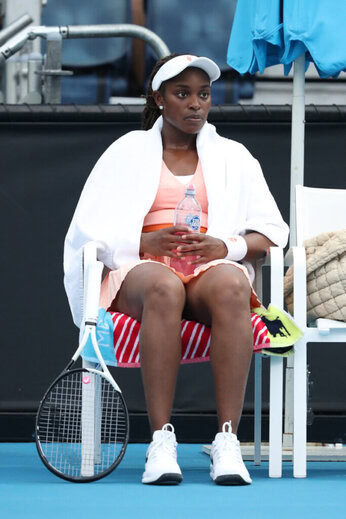The tennis pro and WHOOP ambassador sat down with Boardroom to discuss self-care, style, and how she’s using health data to properly recover.
Sloane Stephens is busy, but she’s not stressed.
From attending Easter egg hunts at the White House to appearing in Icy Hot ads with Shaquille O’Neal, the tennis talent has a full plate from playing in high-profile tournaments to being an ambassador to many top-tier brands. Atop that list of partners is WHOOP, a wearable wellness company that tracks Sloane’s health analytics from rest to recovery.
“I’m figuring out how to manage my day-to-day life and keeping a consistent baseline of where I’m at,” Stephens told Boardroom in regard to WHOOP. “That’s been important for me personally. Seeing the numbers? The data doesn’t lie.”

While tracking sleep statistics and other recovery metrics have played a part in Sloane’s daily routine for the last year and a half, a new feature from WHOOP may matter more for the star athlete, ambassador, and mother.
In March, WHOOP launched a Stress Monitor feature, detecting stress both automatically and in real-time. Aside from making wearers aware of rising stress levels, it gives WHOOP wearers scientifically proven tools to decrease stress at the moment.
Implementing insights from studies led by Dr. Andrew Huberman, the team at WHOOP has found a series of daily breathwork exercises that take a mere five minutes and are shown to improve mood and anxiety levels.
For Sloane, an active athlete who was raised by a psychologist mother, taking care of her physical, mental, and emotional health has been common practice for years before wearable wellness products were available.
From making the most of her WHOOP data to her own self-care routines, Boardroom caught up with Sloane to hear about it all.
IAN STONEBROOK: Go back to the origin of your WHOOP relationship and how it’s evolved over the last couple of years.
SLOANE STEPHENS: I had a trainer who was using WHOOP already and I was like, “Wow, what is that? What are you using?” And that’s literally how I started using it. The partnership with the WTA was kind of already happening and we were being introduced to it, so a few players had it.
I was waiting for a particular band — I wanted a pink one or something very cute — so I just went for it and started. Then the partnership with the WTA happened and we dove into it that way. I’ve been using it ever since.
IS: Early on, what were you hearing from your peers about WHOOP? What insights have you found helpful since you started working with WHOOP?
SS: Most of the WTA players on the tour wear it, so we were able to talk amongst ourselves and figure out how to best utilize it. In the beginning, we were all trying to figure out how to best recover and how to use it for sleep. Some people were always in the green and I was like, “Dude, I’m always in the red! What is going on here?!”
Trying to manage my day with the WHOOP for myself has been helpful and beneficial just because I’m able to see what my days are looking like and how consistent I’m being or not being. I know if I’m taking a week off of tennis or having a vacation, my WHOOP is gonna be like, “Man, what are you doing? You were just in the high-stress zone last week at a tournament, what’s going on?”
I’m figuring out how to manage my day-to-day life and keeping a consistent baseline of where I’m at. That’s been important for me personally. Seeing the numbers? The data doesn’t lie. Being able to see that and make use of it for me has been super helpful.

IS: My colleague Jose Mena told me after our holiday party that his WHOOP recovery was at 1%. We’ve all been there before after a late night but don’t all have the data to back it. When you’re presented with a fun night or long day, how do you use the WHOOP data to recalibrate your next day?
SS: The 1% days? We call those the death days because you’re like not alive, you’re just existing. I’ve had quite a few of those after a super intense three-hour match. You get to bed late and you don’t get good sleep. We’ve all experienced that, but as I said, it’s about keeping a good baseline and really understanding where your body’s at and adjusting to it.
At a tournament, it’s learning how to manage yourself with data. That has been super beneficial for a lot of people just because before you kind of knew, you could feel it. You’d be like, “Oh, I’m tired today because of blah, blah blah.” But now actually looking at the data points and being like, “Okay, I didn’t recover well, I didn’t sleep well, my strain was at 18. I need to do A, B, and C to kind of get back on track.”
Learning that has been a process of what can get you back into the green which is optimal for anyone. That’s where it comes in handy because before, you kind of know you had a rough day. But now you’re like, “Oh, I had a really rough day. I need to cut back or I need to do A, B, and C to get back on track.”
IS: As someone who has played tennis competitively their whole life but is also expressive and very vivacious in nature, what is your relationship like with analytics and how has it evolved?
SS: In terms of analytics and data, I think it’s super helpful because never before have we had something that’s actually telling us you slept five and a half hours and you’re in the yellow today. You need to get more sleep, you need to recover better, you need to do something for your body — whatever it is.
Like I said, having it and seeing it, not letting your life be run by numbers, but seeing it and verifying what happened yesterday? This is what I need to do to improve. Those are the steps that help you become better.
Before, it was kind of a guessing game. Your coach would be guessing or your physio trainer would be like, “Maybe you had a hard day,” but not really knowing your body’s beat up. That’s obviously different for everyone.
I know some girls who are constantly in the green and I’m like, “How are you hitting 30 days in the green?! What time are you going to sleep? How are you being this consistent?” But I think everybody’s different and some people do allow themselves to be run by numbers. They’re in bed at a certain time and they’re resting.
I think it gives you structure also in terms of what you need to do to be in the green. To feel rested, to feel like you have that energy for the next day. That’s really important for some people to use as a marker to get better, to know this is what I need to do.

IS: Your mother is a psychologist. How did that inform your approach to tennis and self-care growing up?
SS: I’m a big believer in therapy. I’m a big believer in taking care of your mental health, self-care, self-love, and all of that. I grew up in a house with psychologists so those types of things were very normal to me.
I feel like as the world has gotten crazier and social media and the way things spread so quickly, things are happening a lot faster and I think we have not taken pauses. Especially for athletes.
I feel like taking a pause when you feel like things are really speeding up and you’re kind of losing control. I think a lot of people get overwhelmed and there’s no one to say, “Hey, it’s okay to take a break. It’s okay to take a pause.”
In my life, it’s been very normalized, but I’m happy now and happy to see that more people are taking breaks. More people are taking care of themselves and really thinking about their future and what happens next. How being an athlete and how being a regular person, how these things are making you feel.
I think talking about feelings, talking about mental health, and talking about self-care are things that I would love to have spoken about more. But I think we’re in the right direction. People aren’t afraid to talk about mental health anymore and that’s a really great thing.
IS: What are some of your current self-care remedies?
SS: I love getting facials. I’m going to Europe now, so I’m really big into facials, getting my skin right for the summer, making sure I’m feeling good, and getting my nails done. I know I’m gonna be in Europe for five weeks, so I’m like, “Okay, like I’m gonna do all of my favorite things now before I go because there might not be my favorite nail salon in Europe.”
So, I’m gonna go and make sure I get my nails done before I go, get another facial, get another massage — like multiple massages. All of those things really just make you feel good, they make your body feel good. It’s to make sure that I feel like I’m taking care of myself when I’m doing those things. I enjoy them and I think that makes a big difference also.

IS: On the side of style, you recently partnered with Free People.
SS: It’s been great. It’s very different from what I’ve just come from, but I feel like it’s a great opportunity to showcase a new brand in a way that they haven’t seen before. FP Movement is just getting started, but having custom tennis lines and custom looks is gonna be really cool because they are designers. Their thing is creating clothes that are in the fashion world, that are comfortable, that are cute, that are sexy, that really kind of push the needle.
I think transitioning that into tennis is really great. I wanted to work with them because it’s kind of their brand already with the sporty girl, the comfortable girl, the cute girl. But it’s taking that and making that really for the girl on the go, like the tennis player. I think that’s super cool. Being able to be a part of it, customize looks, and do everything with them was the appeal of this partnership.
IS: You recently attended the White House. What goes into picking out an outfit for such an occasion?
SS: We went to the Easter egg hunt and we took our 8-year-old and his best friend. They had a great time. We met the President and met the First Lady, the kids played games all day, and it was great.
Going to the White House, you have to have your Sunday best on, for sure. It was obviously special because of the Easter egg hunt, so you wear your best little outfit. I’m always that person who if I’m going somewhere where I wanna look good? I plan my outfits ahead. I make sure that everything is in order. I’m just a planner in general. If there’s somewhere that you’re gonna look really great at, it’s probably gonna be the White House.
IS: That’s fantastic. To close it out, is there anything else Boardroom readers should know or you’d like to get the word out on?
SS: Follow me on LinkedIn because that’s my favorite app.